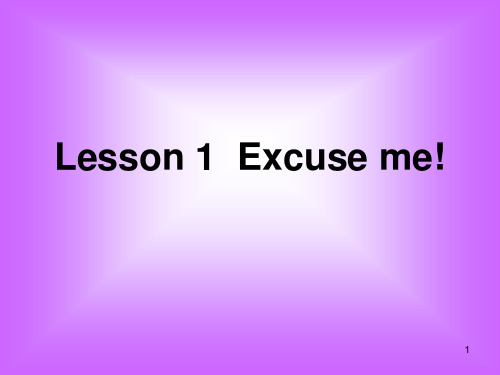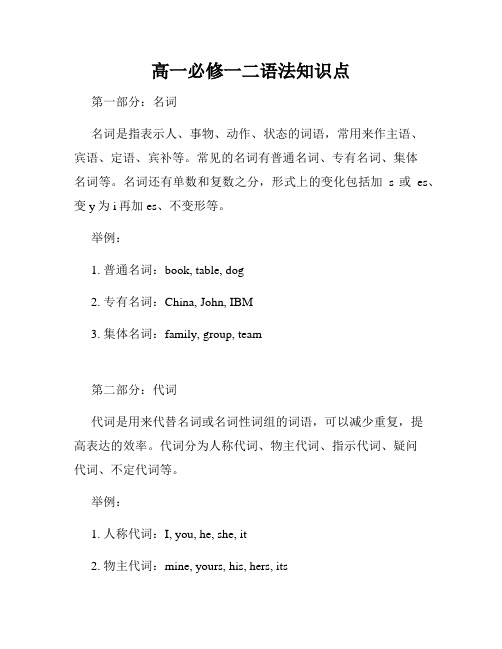新一l1-2语法
- 格式:doc
- 大小:26.50 KB
- 文档页数:1

Lesson 1、2课文知识点:1、Excuse me! 劳驾,对不起。
当引起别人的注意的时候,或打断别人谈话,或从别人身边走过的时候用的客套话。
注意和sorry的区别。
2、Yes?用升调读,“什么事”。
和用降调不相同,用降调表示“是的”的意思。
3、Pardon? 对不起,请在说一遍。
用于口语,正式的说法是:I beg your pardon? 或 Pardon me.4、Thank you very much. 非常感谢。
同义句:Thank you. Thanks!Thanks a lot.Many thanks.回答不客气的几种方式扩充。
5、初步了解人称代词,指示代词,物主代词。
语法:陈述句句型及转换陈述句:This is…这是…陈述句的否定形式:在be动词后加not:This isn’t…这不是…一般疑问句:在系表结构中,一般疑问句把系动词前置,并采用升调阅读:Is this…一般疑问句的回答(be动词引导):Yes, it is.(肯定)No, it isn’t.(否定)例子:Is this your pen?Yes, it is / No, it isn’t.That one is my pen and this isn’t my pen.Lesson 3、4课文知识点:1、My coat and my umbrella please. 祈使句,等于 Give me my coat and my umbrella please.2、Here’s your umbrella and your coat. 这是一个倒装句式,系动词提到了主语之前,正常语序是:Your umbrella and your coat are here.3、了解物主代词中的形物代和名物代。
发音技巧:连读:第一个单词为辅音,第二个单词为元音时将连读。
如:Yes, it is.略读:两个爆破音在一起时,前一个爆破音失去爆破。


高一英语必修一、二语法汇总定语从句1.定语从句的结构及理解2.定语从句的关系词的使用3.定语从句的简化表达知识总结归纳(一)定语从句的结构:在复合句中,修饰某个名词或代词的句子(做这个名词或代词的定语)叫定语从句,定语从句一般放在被修饰的名词或代词后面,被修饰的名词或代词叫做定语从句的先行词,它与定语从句之间要有一个词连接,这个词指代先行词的内容叫做关系词(关系代词或关系副词:that,which,who, whose,when,where,why)。
先行词在定语从句中充当主语,宾语,时间,地点,原因状语。
结构:先行词+关系词+定语从句。
1.There she saw a wall of water that was quickly advancing towards her.2.In Japan,someone who sees another person making the gesture will think it means money.3.A theme park is a collection of rides,exhibitions or other attractions that are based on a common theme.4.The park has a conservation center that helps protect marine animals and their habitats in the rivers and coastal waters of Asia.5.Visitors can go on exciting rides where they can feel what it is like to do the things they have seen their heroes do in the movie.6.Oprah Winfrey is a black woman whose rise to fame is an inspiring story.(二)定语从句分为限定性定语从句和非限定性定语从句:限定性定语从句:从句对先行词进行必要的描述或说明,缺少它,则句义显得不完整,从句与先行词紧密相连。

Lesson 1 ~ 2 Excuse me!一.课前扩展:询问名字1.What’s your Chinese name?你的中文名字是...?My Chinese name is...我的中文名字是...2.What’s your English name?你的英文名字是...?My English name is...我的英文名字叫...3.May I have your name?(更礼貌的表达)我可以知道你的名字吗?My name is ...我叫...二.词汇的扩展1.excuse v.原谅excuse me : 不好意思打扰了sorry : 对不起,抱歉(自己犯了某种过错,表达歉意)2.me pron. 我(宾格)3.yes adv. 1.)是的;2.)什么事?4. be动词包含:am/is /are用法口诀:我用am,你用are,is跟着他她它,单数is,复数are,我们是一家Eg:I am/ you are/he is/she is/it is/we are/ they are缩写:去掉首字母变’5.this pron. 这e.g. This is my friend. 这是我的朋友。
词汇扩展:单数:this 这反义词:that 那复数:these这些反义词:those那些6.my我的,your你的7.handbag n. (女用)手提包bag 包,袋书包:schoolbag购物袋shopping bag8.pardon int. 原谅,请再说一遍Pardon? 对不起,请再说一遍好吗?常用表达:通常用于口语中,当我们没听清对方的话,希望对方再说一遍时。
=I beg your pardon? =Pardon me?9.it 它(不是人的它)It其他意思:天气,时间,距离eg:It is sunny today.(天气)It is 5 o’clock(时间)It is 2 km from my home to school.(距离)10.thank you 感谢你(们)11. very much 非常地课文原句重现:Thank you very much.常用表达:常用的感谢用语还有:a. Thank you!b. Thanks!c. Thanks a lot!12.pen n. 钢笔penciln.铅笔pencil boxn.铅笔盒bookn. 书watchn. 手表13.coatn.上衣,外衣dressn. 连衣裙skirtn. 裙子shirtn. 衬衣14. car n. 小汽车15.house n. 房子housewife家庭主妇housework 家务三.重点语法:课文原句重现:Is this your handbag?(1) 形容词性物主代词your是形容词物主代词,形容词性物主代词在句中起形容词的作用,用在名词前。

新概念英语第一册语法知识点总结《新概念英语》是1997年由外语教学与研究出版社和培生教育出版中国有限公司联合出版的一套英语教材。
第一册有哪些语法知识点呢?接下来店铺为你整理了新概念英语第一册语法知识点总结,一起来看看吧。
新概念英语第一册语法知识点总结(一)第几课教学内容教学目标及要求1-21,Excuse me2,Is this your…?1,要求学生灵活运用句型:Is this your…?2,pardon和excuse me的用法3,L1、2课的单词及L1的课文要求能背诵。
3-43,Sorry,sir.4,Is this your…?1,继续巩固句型:Is this your…?2,新句型:祈使句 My____, please.否定句 This is(not)____.3,L3、4课的单词及L3的课文要求背诵5-65,nice to meet you6, What makeis it?1,主语为第三人称单数的主系表结构,She/ He/I t is…2,了解一些常见国籍的拼读3,This is …(一般用于将某人介绍给他人的句式)4,Nice to meet you.(用于初次与朋友、同学见面的问好)5,认知一些汽车的品牌6,国籍、汽车品牌要求会认读,其他单词及课文要求背诵7-87,Are you a teacher?8,What’s yourjob?1,重点句型:Are you …?/ What’s your job?/ What nationality are you?I’m…(介绍自己:名字,国籍以及职业等)2,I am的缩写(I’m)3,不定冠词a, an9-109, How are you today?10, Look at…1,重点句型:How are you?(朋友或相识的人之间见面时的寒暄话)2,如何问候他人(How is …?)3,nice to see you .(见面时的客气话)4,Look at…(看…)。

高一必修一二语法知识点第一部分:名词名词是指表示人、事物、动作、状态的词语,常用来作主语、宾语、定语、宾补等。
常见的名词有普通名词、专有名词、集体名词等。
名词还有单数和复数之分,形式上的变化包括加s或es、变y为i再加es、不变形等。
举例:1. 普通名词:book, table, dog2. 专有名词:China, John, IBM3. 集体名词:family, group, team第二部分:代词代词是用来代替名词或名词性词组的词语,可以减少重复,提高表达的效率。
代词分为人称代词、物主代词、指示代词、疑问代词、不定代词等。
举例:1. 人称代词:I, you, he, she, it2. 物主代词:mine, yours, his, hers, its3. 指示代词:this, that, these, those4. 疑问代词:who, what, which, whose5. 不定代词:someone, anyone, everyone, something, anything, everything第三部分:动词时态动词时态用来表示动作或状态发生的时间。
英语中常见的时态包括一般现在时、一般过去时、一般将来时、现在进行时、过去进行时、现在完成时等。
举例:1. 一般现在时:I play football every Sunday.2. 一般过去时:She visited her grandparents yesterday.3. 一般将来时:We will go to the beach next summer.4. 现在进行时:They are watching a movie now.5. 过去进行时:He was studying when I called him.6. 现在完成时:We have finished our homework.第四部分:形容词与副词形容词用来描述名词或代词,副词用来修饰动词、形容词或其他副词。
高一英语必修一二语法点1.第一二单元:直接引语变间接引语(P.9 and 33)2.第三单元:现在进行时表将来3.第四单元:定语从句(关系代词)4.第五单元定语从句(关系副词)必修二1.第一单元:定语从句(限制性定语从句,非限制性定语从句)2.第二单元:一般将来时的被动语态(will be p.p)3.第三单元:现在完成时的被动语态(has\have p.p)4第四单元:现在进行时的被动语态(is\am\are being p.p)5.第五单元:定语从句(介词+关系代词)定语从句结构:先行词+关系词(连接词)+从句① 行词是人② 先行词是物③ 一般情况下考的简易的类型:④ 物用which人用who⑤ 所属关系用whose⑥ 逗号之后不可that⑦ 特殊that要牢记特殊that 考点1. all,some,any,no,little,much,few,thing系列,body系列,none, the one.2.the+ 序数词(first,second,last,next)the very, the only3.人+物4.开头已经有who,为避免重复,改用that.定语从句分类:2种1.限制性定语从句2.非限制性定语从句(标志是,)意义上基本上没有区别只通过形式判断就行例句:Yesterday I sold a bike, which I bought a month ago.非限需要注意的问题:千万不可用that, 除此之外连词都可以选择比如常用到的which,who, where, whom….强调句强调句构成:It is\was 被强调部分that +从句例子:I like winter.It is I that like winter.(强调主语)It is winter that I like.(强调宾语)现在进行时表将来结构:am\is\are + doing现在进行时表将来常用词:come go start arrive leave stay初高中误区:am\is\are + doing 不仅仅是现在进行时的标志在高中新的语法知识中:它还能表示将来= will被动语态列举子:I study English.(一般现在时)English is studied by me.I studied English last year. (一般过去时)English was studied by me last year.I am studying English now.(现在进行时)English is being studied by me now.I have studied English for one year.(现在完成时)English has been studied by me for one year.I will study English next week.(一般将来时)第二步:找出时间状语的词现在进行:now, look…现在完成:since, yet, by now,by the end ofever sincefor +一段时间一般将来时:next +时间状语tomorrowin the future……第三步:选择被动语态形式。
Lesson1 –Lesson2一.根据句意和汉语意思写出所缺的单词1.--Is_______(这)your book? --Yes.it is.2.They like_______ (我) very much3.This is my_______ (手提包).4.It’ s a_______ (连衣裙).5.Is this your_______ (外衣)?二.写出与下图相对应的单词。
1.________2.________3. ________4.________5. ________ 三.根据要求完成句子,每空一词。
1.对不起。
这是你的手提包吗?(根据汉语完成句子)______ _______ ,_______ _______your handbag?2.谢谢你,琳达。
(根据汉语完成句子) ______ _______,Linda!3.请你再说一遍。
(根据汉语完成句子) I beg______ _______.4.This is my car.(改为一般疑问句) ______ ______ ______car?5.--Is this a book?(作肯定回答) ---Yes, ______ _____.四.下列句子中均有一处错误,请找出错误,并把正确的句子重新抄写一遍。
1. I beg you pardon. ________________________2. Thanks you very much. ________________________3. This it my watch. __________________________4. Is this you book? __________________________5.--Is this your house? --Yes, this is __________________________ 五.你看到Jerry把书忘在了课桌上。
Unit 11.get(have) sb. done 让某人做某事When he/she borrowed it last time, he/she broke it and you had to pay to get it repaired.2.look through 仔细查看;浏览It’s no pleasure looking through these any longer because nature is one thing that really must be experienced.3.upset vt.使心烦意乱;使苦恼;使伤心①upset oneself about sth. 为某事而烦恼②be/get upset about sth.为某事而烦恼或难过4.dislike vt.不喜欢;讨厌①dislike doing sth.不喜欢做某事;讨厌做某事②dislike one’s doing sth.不喜欢某人做某事;讨厌某人做某事③dislike it when… 讨厌5.concern vt.使担忧;使烦恼;对……负责,与……有牵连n.关系;担心;忧虑;关心的事①concern oneself about/be concerned about 为……担忧②concern oneself with/be concern with 关注;涉及;关于③concerning 关于6.go through 通过;穿过;经受;仔细检查;完成7.look through 审核;浏览8.get along with 与……相处;进展9.before引出时间状语从句常可译为汉语“还没……就……”,“还没来得及……就……”,“……以后才……”或“不等……就……”,此时,从句中可用情态动词can 或couldShe and her family hid away for nearly twenty-five months before they were discovered.她和家人躲藏了两年,后来被发现了。
New Concept English新概念英语一二两册涉及语言点概览Book OneLesson 1-2 陈述句与一般疑问句Lesson 3-4 否定句Lesson 5-6 选择疑问句,a和an的用法区别Lesson 7-8 特殊疑问句Lesson 9-10 社交用语How...?,形容词的意义与作用Lesson 11-12 Whose引导的疑问句,物主代词及其用法,名词所有格Lesson 13-14 What color引导的特殊疑问句,祈使句,and的用法Lesson 15-16 名词的复数形式,be的一般现在时形式Lesson 17-18名词复数的不规则变化,Who引导的特殊疑问句,人称代词主格Lesson 19-20 There be结构,系动词be的变化Lesson 21-22 Which引导的特殊疑问句,人称代词宾格Lesson 23-24 直接宾语和间接宾语,介词on的用法,不定代词one的用法。
代词比较one/that/it Lesson 25-26 介词in的用法,定冠词the的用法Lesson 27-28 Where引导的特殊疑问句,there be与have的区别,There be句式的否定和疑问结构,some和any的用法Lesson 29-30 情态动词mustLesson 31-32 动词的现在分词,现在进行时Lesson 33-34 对现在进行时的陈述句进行提问Lesson 35-36 短语动词Lesson 39-40 祈使句的否定缩略式,双宾语Lesson 41-42 不可数名词Lesson 43-44 情态动词canLesson 45-46 情态动词canLesson 47-48 一般现在时Lesson 49-50 选择疑问句Lesson 51-52 句型What... like?Lesson 53-54 国籍词,like不同词性的用法Lesson 55-56 一般现在时,时间频度副词的位置Lesson 57-58 一般现在时和现在进行时Lesson 59-60 可数名词和不可数名词,完全动词haveLesson 61-62 情态动词must,并列连词soLesson 63-64 形容词的比较级和最高级,禁止做某事Lesson 65-66 反身代词,时间表达法Lesson 67-68 系动词be的一般过去时Lesson 69-70 国籍词,一般过去时Lesson 71-72 动词过去式的构成,一般过去时的用法Lesson 73-74 副词Lesson 75-76 一般过去时与时间短语Lesson 77-78 一般疑问句否定结构Lesson 79-80 must与need的用法,many/much和a lot of,have got的用法Lesson 81-82 完全动词haveLesson 83-84 现在完成时的区别Lesson 87-88 现在完成时的疑问句及否定句Lesson 89-90 情态动词may,for和since引导的时间状语从句Lesson 91-92 一般将来时Lesson 93-94 可与一般将来时连用的时间状语Lesson 95-96 had better与mustLesson 97-98 所有格形容词和所有格代词Lesson 99-100 宾语从句,直接引语和间接引语Lesson 101-102 间接引语的时态,反义疑问句Lesson 103-104 too和enoughLesson 105-106 动词不定式Lesson 107-108 形容词的比较级和最高级及其用法Lesson 109-110 不规则形容词的比较级和最高级,名词的数与修饰词Lesson 111-112 形容词的平级比较:as...asLesson 113-114 so和neither引导的简短回答,no和none的用法Lesson 115-116 不定代词Lesson 117-118 过去进行时,同位语Lesson 119-120 过去完成时Lesson 121-122 定语从句Lesson 123-124 定语从句中的省略Lesson 125-126 have to和mustLesson 127-128 表示猜测和推断的情态动词must和cant't Lesson 129-130 表示猜测和推断的情态动词must和cant'tLesson 133-134 需要改变时态的间接引语Lesson 135-136 Let的用法,间接引语中的情态动词由现在时变为过去时Lesson 137-138 If引导的条件状语从句Lesson 139-140 宾语从句Lesson 141-142 被动语态Lesson 143-144 被动语态Book TwoLesson 1 简单陈述句的语序Lesson 2 一般现在时和现在进行时,感叹句Lesson 3 现在完成时,一般过去时与一般现在时,直接宾语与间接宾语Lesson 4 现在完成时与一般过去时的区别,现在完成时与现在进行时的区别,同位语Lesson 5 带way的一些短语,不定冠词和定冠词,一般过去时与现在完成时的区别Lesson 6 短语动词,现在进行时,a/the与some的用法Lesson 8 形容词和副词的比较级和最高级Lesson 9 被动语态,引导时间状语的介词in、on、at、during、till与until,否定句的两种形式:not any与noLesson 10 现在进行时和过去进行时的被动语态,双重所有格Lesson 11 动词+名次/代词+带to的不定式Lesson 12 一般将来时Lesson 13 将来进行时,名词所有格Lesson 14 过去完成时Lesson 15 直接引语和间接引语Lesson 16 条件句Lesson 17 must、have to和have got to的用法Lesson 18 实意动词have的用法Lesson 19 表示许可的can和mayLesson 20 介词与动名词Lesson 21 情态助动词在被动语态中的使用,be supposed to和be used to的用法Lesson 22 一些常见的动词词组Lesson 23 There is和It is的用法Lesson 24 感叹词wellLesson 25 并列句的语序Lesson 26 一般现在时与现在进行时的动词使用Lesson 27 表示过去习惯动作的used to和一般过去时的特殊用法Lesson 28 现在完成时与since,关系从句及关系代词Lesson 30 定冠词the的用法,some与any的区别Lesson 31 过去进行时和一般过去时,used to do的用法Lesson 32 比较结构表示法,little和few的用法Lesson 33 表示方向和目的的借此和副词Lesson 34 被动语态Lesson 35 过去进行时和一般过去时,现在进行时,used to do的用法Lesson 36 will和be going toLesson 37 一般将来完成时,将来完成进行时Lesson 38 过去完成时与从属连词when、before、after、untilLesson 39 间接引语中的say、tell和ask,间接一般疑问句,间接疑问词疑问句Lesson 40 条件句Lesson 41 must的用法,have to的用法,need的用法Lesson 42 have+名词代替普通动词Lesson 43 can的用法,be able to 的用法Lesson 44 动名词与不定式,介词by 和with的用法Lesson 45 被动语态中by词组的使用Lesson 46 动词与介词to、at、for和with的搭配Lesson 47 复杂介词Lesson 48 关系副词引导的定语从句Lesson 49 复合句的语序Lesson 50 动态动词和表态动词Lesson 51 一般过去时Lesson 53 一般过去时、现在完成时与现在完成进行时Lesson 54 a与someLesson 55 used to和wouldLesson 56 比较结构的修饰语,the same as的比较结构,different from的比较结构Lesson 57 用于描写人物的介词in和with,表示地点和位置的介词和副词in/at/offLesson 58 由get与过去分词构成的被动语态,It is said that...结构Lesson 59 no和none,表示目的的几种方式:to/in order to/so as to/so that/in order that Lesson 60 现在进行时表示将要发生的事Lesson 61 It is the first time that...结构Lesson 62 过去完成时,过去完成进行时Lesson 63 祈使句的间接引语Lesson 64 条件句Lesson 65 表示“应该”和“必须”的情态助动词must/have to/should/ought toLesson 66 使役动词have的用法Lesson 67 can/be able to/manage to的比较Lesson 68 动词与动名词Lesson 69 被动语态中的动词词组,不定式的被动语态,现在分词的被动形式Lesson 70 形容词后的介词Lesson 71 一般现在时表示将来时Lesson 72 情态动词must,although与thought用法比较Lesson 73 并列结构Lesson 74 when(whenever)/where的用法比较Lesson 76 动态动词和静态动词Lesson 77 非限制性定语从句Lesson 78 反身代词作同位语Lesson 79 一般过去时与过去进行时的配合使用Lesson 80 介词+动名词作状语Lesson 81 介词with的用法Lesson 82 动词+不定式Lesson 83 状语从句分类Lesson 84 先时性和后时性Lesson 85 will/shall+不定式进行时/完成时Lesson 86 并列连词Lesson 87 完全句和不完全句Lesson 88 先行词it的用法Lesson 89 名词性从句Lesson 90 并列连词or及其相关短语连词Lesson 91 时间状语从句Lesson 92 动词分词的逻辑主语Lesson 93 被动态的使用Lesson 94 介词与形容词的搭配关系Lesson 95 过去完成时在虚拟语气中的运用Lesson 96 英汉被动意义表示法比较。
新概念(一)之——日积月累Lessons 1-2
Ⅰ.我认识“你”
(建议根据音标记忆单词,千万不要标注中文)
1.excuse (v.动词)
2.me宾格(pron.代词)→I 主格(永远大写)
口诀:主格放在谓语前,宾格跟在动、介后。
活动筋骨:①am a teacher.
②Give a book. ③Look at . Excuse me!用于:(1)向陌生人搭话;(2)打断别人谈话或想要插话;(3)从别人身边挤过(借过)。
3.yes (adv.副词)→“↑”(升调)什么事?
“↓”(降调)是的。
4.be动词→be妈妈的三个孩子们:am, is, are
口诀:我用am,你用are,is跟着他、她、它,复数全部都用are。
活动筋骨:①I a student. ②You a teacher.
③He a boy.④It a dog.⑤We students.
5.this: (指示代词)→口诀①:见到th就要咬舌尖;
口诀②:this,these靠近我, that,those远离我,
this, that指单数, these, those指复数。
6.your (形容词性物主代词,表示……的)
7.hand手+ bag包=handbag手提包(n.名词)
8.pardon (int.感叹词)请再说一遍“↑”升调
9.it: ①It is a dog. ②Give it to me.
结论:主宾一致
10.Thank you very much./Thank you!/Thanks!
不用谢!①You are welcome. ②That’s all right.
③Never mind. ④It doesn’t matter.
⑤Not at all. ⑥My pleasure.
11.pencil: pencil-box (硬) pencil-case(软)
12.watch: ①(n.)手表②(v.)观看watch TV
13.shirt: 衬衫(男)→T-shirt T恤
14.house / / 房子→区别:horse / / 马
Ⅱ.今日说“法”
一、代词:英语中代词的分类非常详细,初学阶段重点掌握的有人称代词和物主代词。
人称代词:指代人称,代替名词,有主格(用做句子主语),宾格(用做宾语)两种形式。
物主代词:用于修饰名词,表示“……的”
人称代词物主代词
主格宾格
我I me my
你you you your
他he him his
她she her her
它it it it
我们we us our
你们you you your
他们they them their
二、一般疑问句
在英语中,句子通常分为四种类型,分别是陈述句、疑问句、祈使句和感叹句。
而疑问句又被分为四类,即一般疑问句、特殊疑问句、选择疑问句和反意疑问句。
一般疑问句是其中用的较多的一种疑问句。
陈述句变一般疑问句的方法分为以下四个步骤:
1)找到陈述句中的助动词,第一课中主要找be动词(am, is, are);
2)找到be动词首字母大写提句首;
3)主语紧随其后(注:I变you,my变your);
4)句末加问号。
注意:1.一般疑问句通常直接用“Yes”或者“No”来回答,且读的时候要用升调↑;
2.译为“……吗?”
eg. ①This is my book. →Is this your book?↑
Yes, it is./ No, it isn’t.
②I am a teacher. →Are you a teacher?↑
Yes, I am./ No, I am not.
一般疑问句例句:
Do you like English? Can you fly? …
Ⅲ.实战演习
一、Read and Choose
( )1.My name Lisa. I from China.
A.is/am
B.are/is
C.is/are
( )2.Are a nurse?
A.he
B.you
C.I
( )3.Is Alan a student? No, .
A.she is
B.he is
C.he isn’t
( )4.Are you Tina?
A.Yes, I’m.
B.Yes, I am not.
C.Yes, I am.
二、Read and Change
1.This is my house.(转换为一般疑问句)
2.Is this his car?(否定回答)
3.Is this her dress?(肯定回答)
4.Is this our car?(要求重复)
三、Read and Translate
1.打扰一下。
这是您的手表吗?
2.您说什么?
3.非常感谢。
4.不客气。